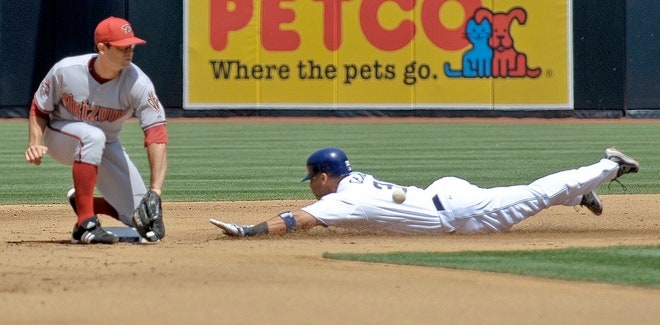Yes, in baseball, players can slide into first base, although it is more common to run through the base without sliding. Sliding into first base can slow players down, so it is not encouraged unless there is a need to avoid a tag or if the player believes it will help them reach the base faster.
It is important to note that sliding into first base is allowed but not required.

Credit: www.wired.com
The Mechanics Of Sliding In Baseball
Sliding in baseball is an essential skill that allows players to safely reach a base, evade tags, and gain a competitive advantage. The mechanics of sliding involve a combination of technique, speed, and agility. Understanding the different types of slides, their benefits, risks, and the slide rule in baseball can greatly enhance a player’s performance on the basepaths. In this section, we will explore the mechanics of sliding in baseball, with a focus on feet-first vs head-first slides, the benefits and risks of sliding into first base, and an understanding of the slide rule in baseball.
Feet-first Vs Head-first Slides
When it comes to sliding into first base, players have the option to choose between two techniques: feet-first and head-first slides. Let’s take a closer look at each technique:
| Feet-first slides | Head-first slides |
|---|---|
| Players slide with their feet leading the way. | Players dive head-first towards the base. |
| Offer more stability and control during the slide. | Allow for faster and more aggressive slides. |
| Decrease the risk of injury as the feet absorb impact. | Increase the risk of injury, especially to the head, hands, and arms. |
| Commonly used by players to maximize speed and maintain momentum when sliding into a base. | Used when players need to reach the base quickly or evade tags from the fielder. |
When deciding between feet-first and head-first slides, it is important for players to consider the specific game situation, their own skill level and comfort, and the potential risks involved. While head-first slides can be more aggressive and potentially result in faster base reach, there is an increased risk of injury and the chance of being called out due to the slide rule.
The Benefits And Risks Of Sliding Into First Base
Sliding into first base is a controversial move in baseball, as it does not always provide a clear advantage to the baserunner. Let’s explore the benefits and risks associated with this technique:
- Benefits of sliding into first base:
- Can potentially help baserunners avoid a tag and reach the base safely.
- Allows for a quicker deceleration, potentially reducing the risk of overrunning the base.
- May create a distraction for the fielder, increasing the chances of an error.
- Risks of sliding into first base:
- Sliding may slightly slow down the baserunner compared to running through the base.
- There is a risk of injury, especially with head-first slides.
- The slide rule in baseball restricts certain sliding techniques, which can result in being called out.
Ultimately, the decision to slide into first base should be made based on the specific game situation, the player’s assessment of the risks and benefits, and their own playing style and comfort level. It is important for players to be aware of the rules and regulations surrounding slides to avoid unnecessary penalties or injuries.
Understanding The Slide Rule In Baseball
The slide rule in baseball governs the legality of slides and aims to protect players from unnecessary collision and injury. Here are some key points to understand about the slide rule:
- The rule prohibits runners from using a “roll block” or initiating contact with the fielder.
- Failure to slide or engage in a legal slide can result in being called out at the umpire’s discretion.
- Runners must slide or attempt to avoid contact when there is a play on the base that can potentially lead to a tag.
- Umpires interpret the slide rule based on the fielder’s position, intent of the runner, and the nature of the slide.
Understanding and adhering to the slide rule is crucial for players to avoid penalties and maintain a safe playing environment. It is recommended for players to familiarize themselves with the specific rules and interpretations set by the league they are participating in.
Credit: www.quora.com
Why Players Don’t Typically Slide Into First Base
Sliding into first base in baseball is generally not encouraged because it slows down the runner. Unlike other bases, players can run past first base without being tagged out, so maintaining high speed by running through the base is more advantageous than sliding.
The Speed Advantage Of Running Through First Base
In baseball, players typically choose to run through first base instead of sliding. This is because running through first base allows them to maintain their speed and momentum, giving them a better chance of reaching the base safely. Sliding, on the other hand, slows down the runner and can increase the risk of getting tagged out by the fielder.
By running through first base, players can maintain their highest rate of speed for a longer period of time. This can be crucial, especially when a close play is expected at first base. It allows the runner to make a quicker and more efficient decision based on the fielder’s positioning and the time it takes for the ball to reach the first baseman.
Additionally, running through first base can also help the runner avoid potential injuries. Sliding into the base can put additional strain on the player’s body, especially if they are sliding headfirst. By choosing to run through the base, players can minimize the risk of unnecessary injuries and stay in the game for longer.
Exceptions To The Rule
While runners typically run through first base, there are some situations where sliding may be more advantageous. For example, if the runner is trying to avoid a tag from the first baseman or if they need to adjust their positioning to reach the base quicker, sliding may be a viable option.
In some cases, the choice to slide into first base may also come down to a player’s personal preference or previous experiences. Some players may have had success sliding into first base in specific situations and may choose to continue using that technique in the future. Ultimately, the decision to slide or run through first base may vary based on individual factors and game situations.
Umpire Discretion And Illegal Slides
While runners are generally allowed to run through first base without being tagged out, there are certain situations where sliding may be required. According to the slide rule, runners must slide into the base if they are being played upon, except for first base.
However, it’s important to note that umpires have discretion when it comes to enforcing sliding rules. In certain circumstances, an umpire may call a runner out if they do not slide into the base, even if the slide rule may not technically apply.
Furthermore, there are specific rules regarding what constitutes an illegal slide in baseball. The slide rule prohibits runners from using techniques such as the “roll block” or attempting to initiate contact with the fielder by elevating and kicking their leg above the fielder’s knee, throwing their arm or upper body, or grabbing the fielder.
In conclusion, while sliding into first base is not a common practice in baseball, there are exceptions where it may be advantageous. The choice to slide or run through first base depends on factors such as speed, momentum, personal preference, and game situations. Umpires have discretion when it comes to enforcing sliding rules, and there are regulations in place to prevent illegal slides.
The Role Of Sliding In Baseball Strategy
Sliding into first base is not a common strategy in baseball due to the fact that it slows down the runner. While sliding is typically done feet-first, some players may choose to slide head-first. However, going headfirst into the base is considered more of a dive than a slide.
Utilizing Slides To Avoid Tags
Sliding is an integral part of baseball strategy, especially when it comes to avoiding tags. By executing a well-timed slide, runners can quickly change direction and evade the fielder’s attempts to tag them out. When a runner approaches first base, they must make a split-second decision on whether to slide or continue running at full speed. It’s important to note that while sliding into other bases is common practice, sliding into first base is not typically recommended due to the risk of slowing down. However, there are situations where utilizing a slide can help a runner avoid being tagged out at first.
Strategic Use Of Sliding In Stealing Bases
Slides also play a crucial role in stealing bases. When attempting to steal a base, a runner needs to combine speed, agility, and timing to outsmart the defense. Sliding allows runners to maintain momentum and lower their profile, making it harder for the catcher to make a clean tag. By sliding, runners can decrease the chances of being caught stealing and increase their chances of reaching the desired base safely. It’s a strategic maneuver that requires not only skill but also a thorough understanding of the game situation and the opposing team’s defensive capabilities.
Developing Sliding Skills For Young Baseball Players
For young baseball players, learning proper sliding techniques is essential to their development. Coaches and instructors should prioritize teaching young athletes the fundamentals of sliding to ensure their safety and effectiveness on the field. By providing guidance on form, technique, and decision-making, coaches can help young players develop the necessary sliding skills. It’s crucial to emphasize the importance of practicing slides in controlled environments to minimize the risk of injury. As players gain experience and confidence, they can enhance their overall base-running abilities and become more well-rounded athletes.

Credit: www.theguardian.com
Frequently Asked Questions On Can You Slide Into First Base In Baseball?
Can You Slide Head First Into First Base?
Players can slide head first into first base, although it is more common to slide feet-first. Sliding head first is considered more of a dive than a slide, but both techniques are used in baseball. Sliding into first base is not encouraged because it slows down the runner, and they can run past first base without being tagged out.
Additionally, runners are not required to slide into first base unless they are being played upon by the defense.
Why Do Batters Not Slide To First Base?
Batters do not slide to first base in baseball because it slows them down. Players are allowed to run past first base without being tagged out. By running through the base, they can maintain their highest speed longer compared to sliding at the last moment.
Additionally, the slide rule prohibits runners from initiating contact with the fielder.
Can You Slide Into First Base In 10u Baseball?
In 10u baseball, players can slide into first base. It is common for players to slide feet-first, but some may also use a head-first technique. Sliding into first base can slow down the runner, so it is not always encouraged.
However, in certain situations, sliding may be beneficial to avoid being tagged out.
What Is An Illegal Slide In Baseball?
An illegal slide in baseball involves a runner using a “roll block” or attempting to initiate contact with the fielder by elevating and kicking the leg, throwing the arm or upper body, or grabbing the fielder. The slide rule prohibits such actions.
Conclusion
In baseball, sliding into first base is not a common practice. Players generally opt for running through the base rather than sliding because it allows them to maintain their highest rate of speed for a longer period. Sliding into first base can actually slow you down.
While sliding is permitted and sometimes used as a head-first technique, it is more of a dive than a slide. The slide rule in baseball prohibits runners from making contact with the fielder in any way. Overall, sliding into first base is not encouraged due to its potential decrease in speed and risk of contact.

General Manager & Auditorial Head.
Killian Jake is a World Sports Traveler and hobbyist sports lover. By exploring different sorts of playing modules like indoor, outdoor, and many more. As for professionalism and writing, it’s helpful to give you the right suggestions on different games and sports.





